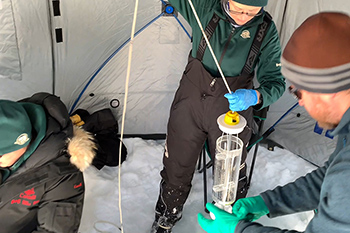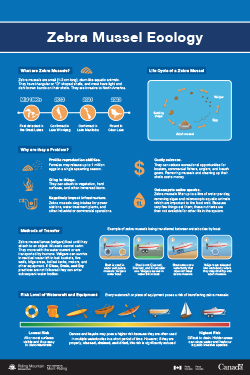
Photo: Perry Au
Facts and FAQs about AIS
Riding Mountain National Park
UPDATE March 2024:
Second set of water samples taken from Clear Lake has tested negative for zebra mussel environmental DNA (eDNA)
The second set of water samples collected from Clear Lake between February 2 and February 20, 2024, have all tested negative for zebra mussel environmental DNA (eDNA). Zebra Mussels may be present despite negative eDNA results. Water samples have now been taken from 34 percent of Clear Lake's area, and all high-priority sections have been tested. Winter sampling will continue until all sections have been tested or as long as weather and ice conditions permit.
Due to the complexity of the situation and ongoing research efforts, no decision has been made regarding the use of Clear Lake for 2024. Parks Canada remains committed to making the best decision based on available scientific evidence in combination with input received from stakeholders. Parks Canada also understands the importance of Clear Lake to Indigenous Peoples, visitors, and the local community.
A potential infestation of zebra mussels in Clear Lake presents a real threat of significant and irreversible ecological damage to the lake and downstream waterbodies.
Full consideration will be given to all aspects of this situation before any decision is made about lake use for the summer of 2024.
What do you need to know?
- Any changes made to the AIS Prevention Program in Riding Mountain National Park for 2024 will be widely communicated once a decision is made.
- There are only two ways Zebra Mussels can spread. Their microscopic larvae (called veligers) cannot swim. They follow water currents or are transported by humans. This means they can easily affect downstream waterways connected to an invaded area.
- In cold water, zebra mussels are less metabolically active and are much less likely to shed eDNA. If a water sample tests positive for eDNA, there is a high likelihood of a population of zebra mussels nearby. Water samples will continue to be collected during open water season.
- Determining with relatively high confidence where a population may exist in the lake will help inform management decisions.
- Parks Canada remains committed to working with partners to reduce the risk of AIS spreading in the park and downstream through southern Manitoba, no matter the results of the winter monitoring.
UPDATE February 2024:
The first set of water samples collected from Clear Lake between January 8 and February 2, 2024, have all tested negative for zebra mussel environmental DNA (eDNA). Zebra Mussels may be present despite negative eDNA results. Water samples are being tested at the University of Manitoba Freshwater Institute operated by Fisheries and Oceans Canada. A second set of samples collected since February 3 was recently sent for testing.What kind of research is being done to better understand the status of zebra mussels in Clear Lake?
Water samples from Clear Lake are being tested for zebra mussel environmental DNA (eDNA) at the University of Manitoba Freshwater Institute operated by Fisheries and Oceans Canada.
The attached map shows Clear Lake broken into 219 sections. Water samples are taken from each section based on priority. High-priority sections are closest to boat launches, beaches, and other areas of human use. Zebra mussels are most likely to first become established at these locations. Most high-priority sections (in green) were included in the first round of samples that were tested. The remaining high-priority sections (in red) have now been sampled and will be included in the samples shipped earlier this week.
Currently, samples are being collected from the bright yellow sections. These yellow sections are up to ten metres deep and zebra mussels could become established in these locations. Winter sampling will continue until all sections have been tested or as long as ice conditions permit.

In November 2023, Parks Canada officials reported live zebra mussels in Clear Lake at Boat Cove, Riding Mountain National Park. The discovery prompted the search for evidence that there might be more zebra mussels somewhere in Clear Lake.
Parks Canada staff at Riding Mountain National Park are working with aquatic invasive species specialists from other Parks Canada sites, the Manitoba Aquatic Invasive Species Unit, and the Department of Fisheries and Oceans Canada to minimize the impact of the recent discovery of zebra mussels in Clear Lake.
The likelihood of success for any potential management action will depend on whether an intervention can happen before significant reproduction and spreading occurs within the lake. Determining with relatively high confidence where they exist in the lake would help to inform management options.
Management decisions are founded on Parks Canada’s legislated mandate and commitment – as a first priority – to protect ecological integrity and are informed by studies, monitoring, and scientific data. Parks Canada is working closely with partners and other jurisdictions to ensure the most appropriate, evidence-based decisions.
FAQs (Frequently Asked Questions):
What are zebra mussels and why are they a problem?
Zebra Mussels (Dreissena polymorpha) are freshwater hinged mollusks. You can identify them by their:
- Flat underside
- Triangular shape
- Varying zigzagged patterns of black or brown with white and yellow
- Average size of 2 to 2.5 cm, reaching up to 4 cm long
In Canada, Zebra Mussels cause millions of dollars in damage every year by clogging intake structures in power stations and water treatment plants as well as damaging watercrafts.
Zebra Mussels are filter feeders that attach themselves to solid surfaces. They breed very quickly, as females can release up to one million eggs each breeding season. After the eggs are fertilized, larvae (called veligers) emerge and are free-floating for up to a month. The larvae are microscopic and do not swim. Veligers will follow lake and river currents until they settle on a solid surface. This natural dispersal method means they can easily affect waterways downstream from an invaded area.
Zebra Mussels can colonize in densities of over 700,000 individuals per m2 on surfaces such as:
- Boats
- Docks
- Rocks
- Plants
- Native mussels
Zebra Mussels can have significant negative impacts on freshwater habitats, such as:
- Altering the food web by out-competing native species, like native mussels and other small invertebrates, for food (plankton).
- Removing large amounts of non-toxic algae (plankton) from the water and leaving behind toxic algae (cyanobacteria) to thrive, causing toxic algal blooms
- Affecting fish spawning areas by changing the surfaces of rocks and vegetation, impacting the survival of fish eggs
- Creating clearer water, allowing sunlight to penetrate deeper and changing the habitat by increasing the growth of submerged aquatic vegetation.
- Increasing pathogenic bacteria, avian botulism, and localized anoxia
Zebra Mussels are especially harmful for native mussels, many of which are species at risk. They outcompete these species for food and will attach themselves to native mussels, suffocating them.
What kind of research is being done to better understand the status of zebra mussels in Clear Lake?
Parks Canada resource conservation staff will take water samples from beneath the ice beginning January 2024. Water sampling for eDNA will be prioritized based on access points like boat launches and recreational beaches, where mussels are most likely to colonize first. These samples will be sent to the Fisheries and Oceans Canada laboratory in batches, where they will receive priority testing. We expect to receive results as soon as they are available.
What will Parks Canada do if all water samples taken from Clear Lake this winter test negative for zebra mussel eDNA?
Zebra Mussels may still be present despite negative eDNA results. Positive eDNA samples can, however, give us a better idea of where a colony might be located. During the open water season, Riding Mountain National Park will continue with a monitoring program for eDNA, veligers and zebra mussels to inform a response option.
Parks Canada remains committed to working with partners to reduce the risk of AIS spreading in the park and downstream through southern Manitoba, no matter the results of the winter monitoring.
What will Parks Canada do if water samples taken from Clear Lake this winter test positive for zebra mussel eDNA?
If a water sample tests positive for eDNA, Parks Canada will begin the next steps to find a population of zebra mussels at or near that sample location. An underwater remotely operated vehicle (ROV) with a high-resolution camera will be used to safely perform a visual search beneath the ice. Divers may be brought in to confirm any evidence gathered.
During dormancy, zebra mussels are less active and are much less likely to shed eDNA. Therefore, if a water sample tests positive for eDNA, there is a very high likelihood of a population of zebra mussels beneath the ice.
What can be done to eradicate zebra mussels?
There is no perfect method to eradicate zebra mussels from a large waterbody. A wide range of studies and experiments have been conducted provincially, nationally, and internationally on zebra mussel eradication, with varying degrees of success.
Currently, the only federally approved pesticide intended for aquatic invasive species is potassium chloride (potash) and many factors contribute to the feasibility of this treatment method. First and foremost, there must be an identified location of a colony. Other factors include the size and extent of the colony discovered, and environmental conditions (currents, ice cover, wind, precipitation etc.).
How are environmental concerns factored into a possible response plan?
Detailed Impact Assessments are developed by Parks Canada impact assessment professionals, to outline the environmental impacts that may be associated with response and treatment methods being considered for Clear Lake. This entails taking a thorough look at the potential short-term and long-term impacts to the plants and wildlife of Clear Lake and how to mitigate or reduce those impacts if treatment were to take place such as: impacts to water quality, fish, invertebrates, vegetation, and visitor experience.
Parks Canada has the highest regard for the ecological integrity of Clear Lake and surrounding ecosystems, any pesticide considered would be carefully evaluated and used in the most serious of circumstances.
Will visitors be able to go ice fishing on Clear Lake?
Ice fishing is currently permitted on Clear Lake. During the closed-water season, Parks Canada reminds all anglers to follow all winter AIS prevention and decontamination regulations.
Any equipment (augers, ice scoops, fishing equipment, etc.) used in water bodies other than Clear Lake must be completely dried off or left out for three days at -10°C or colder before use.
Winter-specific AIS prevention and decontamination methods are available on the provincial website here: https://www.gov.mb.ca/stopais/checklist/winter.html
More information about fishing
What does this mean for access to Clear Lake in 2024?
Parks Canada is working closely with its partners and other jurisdictions to ensure that the most appropriate and evidence-based decisions are made in the management of Clear Lake. At this stage, all options are being considered but no decisions have been made regarding lake use in summer 2024. Parks Canada is committed to working with others to reduce the impacts of zebra mussels in Clear Lake. We understand that people have strong connections to Clear Lake, and we are endeavouring to have information regarding lake use announced in a timely fashion.
Will zebra mussels kill the lake?
All bodies of water have different organic and inorganic compositions. It is impossible to predict exactly how zebra mussels may change the ecology of Clear Lake.
Parks Canada’s top priority is maintaining and restoring ecological integrity, what does that mean?
Parks Canada wants people to enjoy Canada’s national parks throughout the country while maintaining the parks’ ecological integrity. An ecosystem has ecological integrity when...
- It has the living and non-living components expected in its natural region.
- Its processes (the engines that make an ecosystem work, e.g. fire, flooding, predation) occur with the frequency and intensity expected in its natural region.
Ecological integrity is an important priority in all aspects of managing a national park.
Parks Canada runs an ecological integrity monitoring program across all parks. This involves taking an inventory of what is found at each park and monitoring how it is doing.
For example, is a particular species increasing or decreasing in population?
The monitoring program involves data collection for more than 700 different measurements that tell us about how parks are doing. These could include, for example, flora inventory, average monthly precipitation, soil quality, and water quality levels. Monitoring and reporting on the ecological integrity of parks allows Parks Canada, in collaboration with partners, to make informed decisions about protected areas, and to inform Canadians and other audiences.
Do zebra mussels help by cleaning dirty water?
Zebra mussels can filtre 1 litre of water per day, consuming plankton, and small organisms that native species rely on. Zebra Mussels can have significant negative impacts on freshwater habitats by out-competing native species for food. When found in high densities, the mussels can have strong impacts on algae, which are the base of the food web. The plankton is filtered and ingested, but toxic algae is not consumed, allowing it to accumulate to dangerous levels.
Do birds and turtles spread zebra mussels?
The “gizzard” or digestive tract of birds destroys zebra mussels, therefore there is no risk of spreading zebra mussels through bird droppings. Wildlife living near waterbodies, such as waterfowl and turtles, do not stay still long enough for a zebra mussel larva to secure itself. Turtles move slow and dry quickly between waterbodies. Waterfowl such as ducks and geese do not soak up water with their feathers. These birds have the ability to keep dry due to the structure of their feathers and the oils they groom themselves with.
Can zebra mussels swim?
Mussels cannot swim freely at any point in their lifecycle. During the larval phase, the zebra mussel larva (veliger) free-float in the water until it attaches to an object. That larvae will develop a shell and tendrils that secure the mussel in place. Clams, on the other hand, can swim using a foot-like appendage.
For more information contact: comms-riding@pc.gc.ca
Information:
Related links
- Date modified :


 579 KB
579 KB

